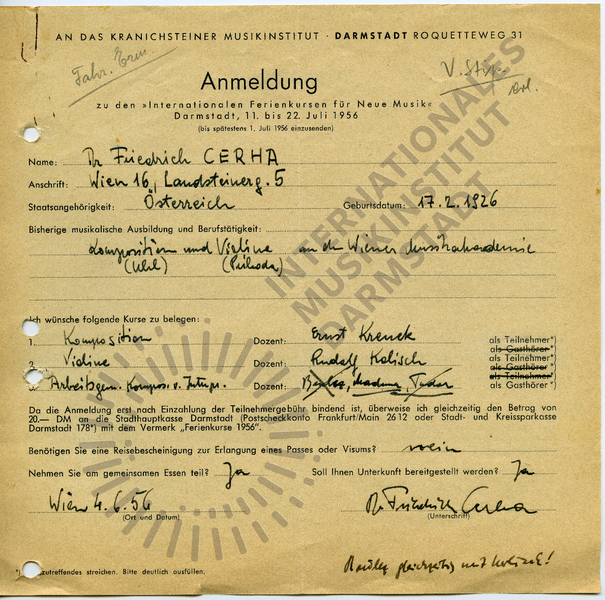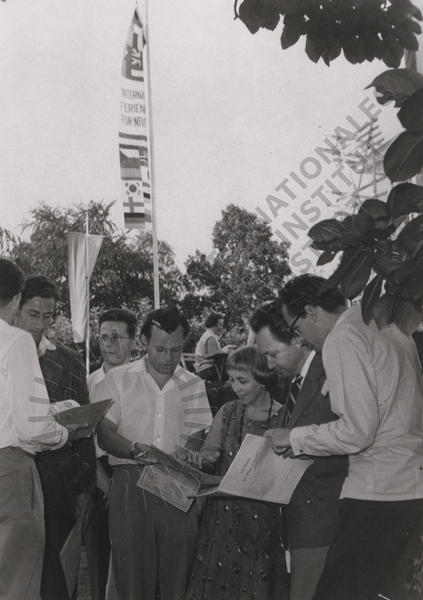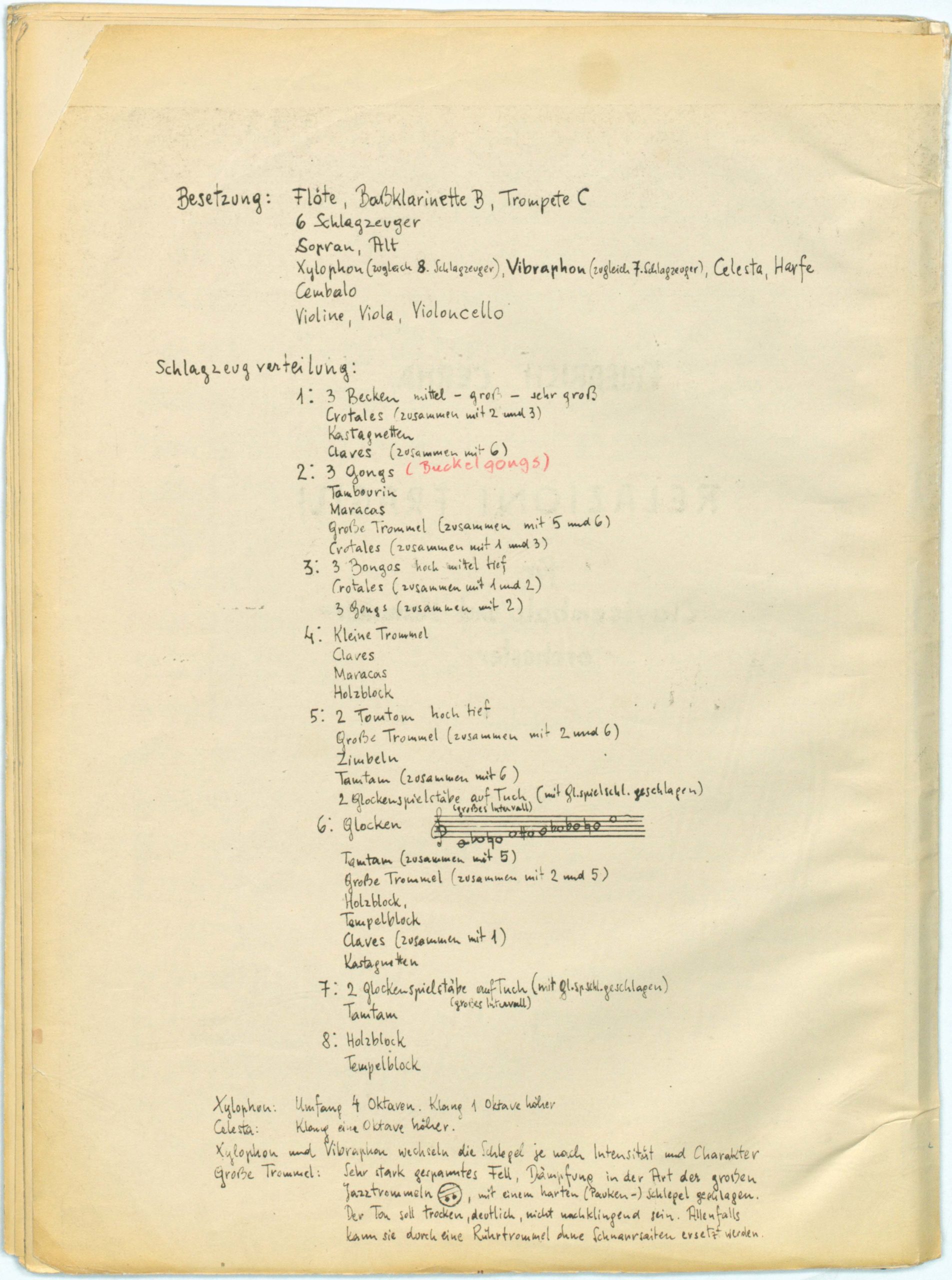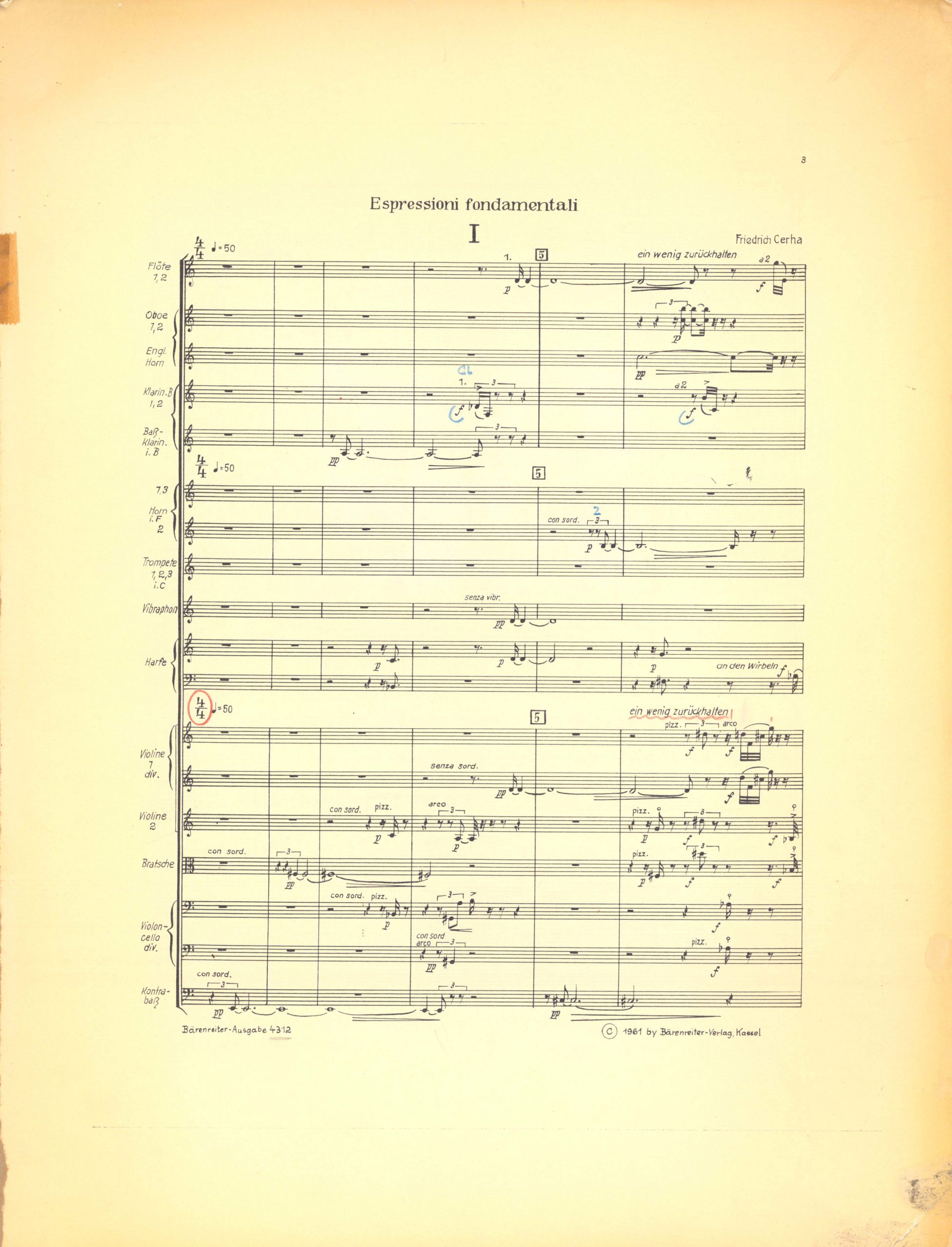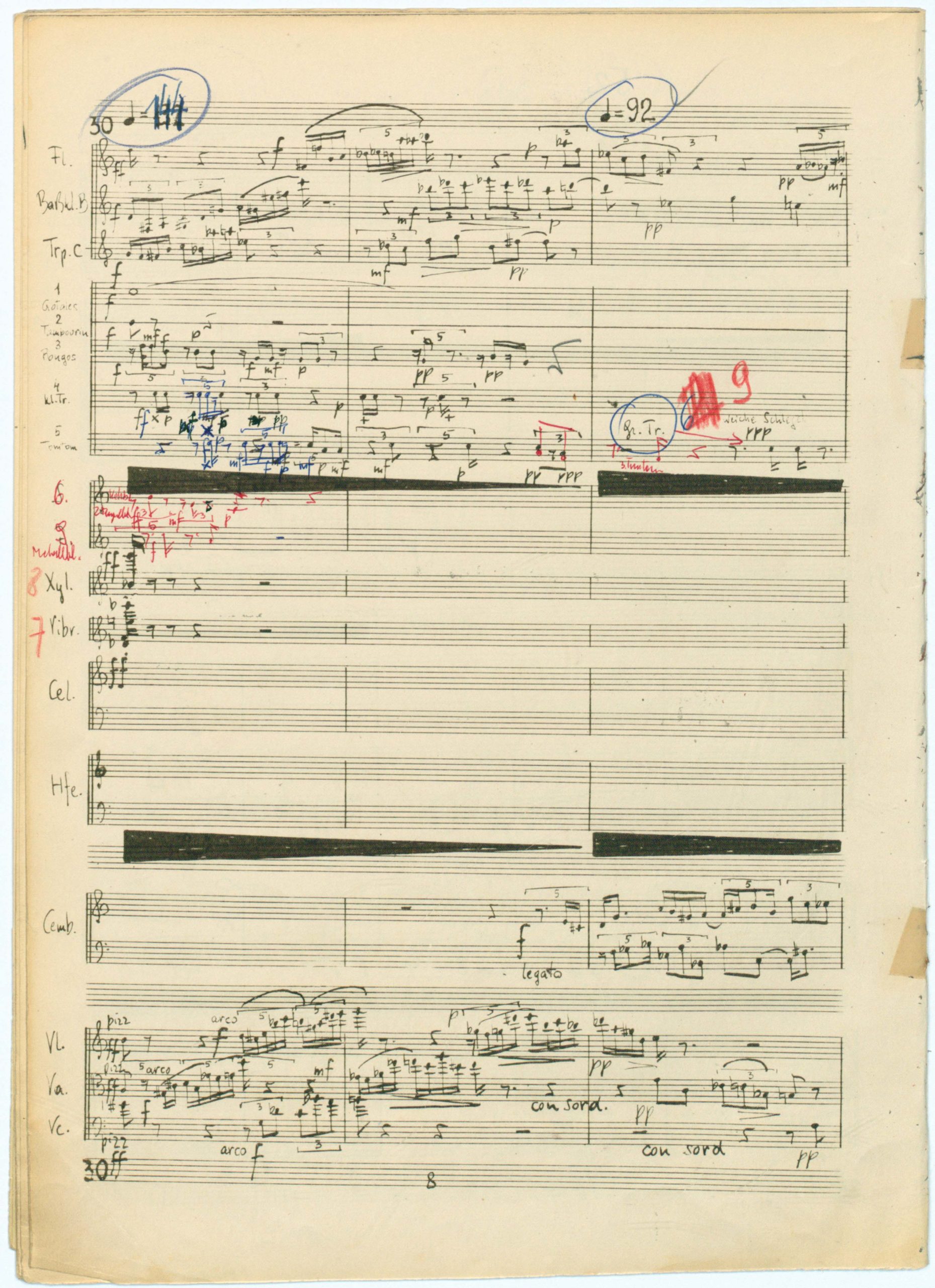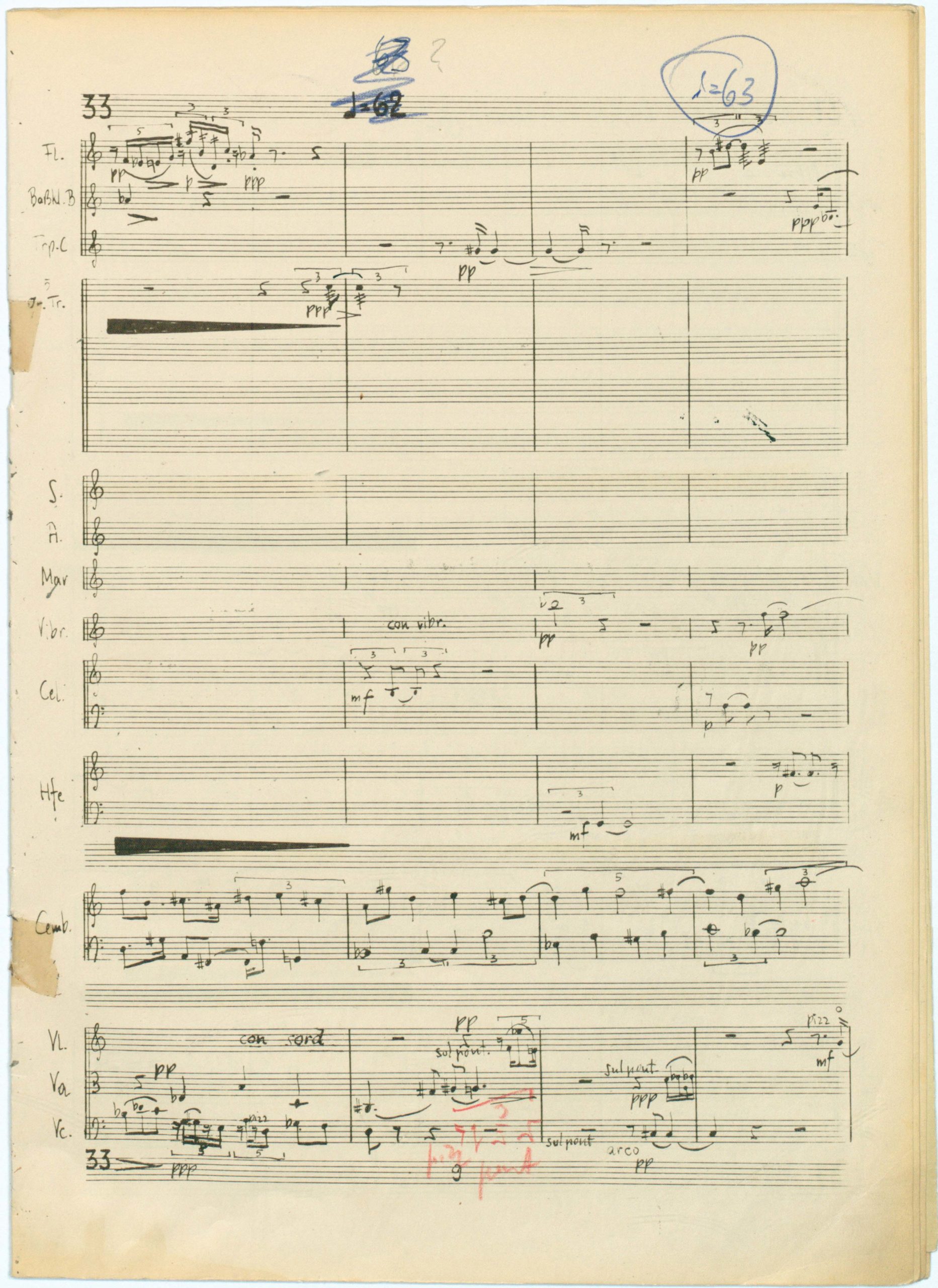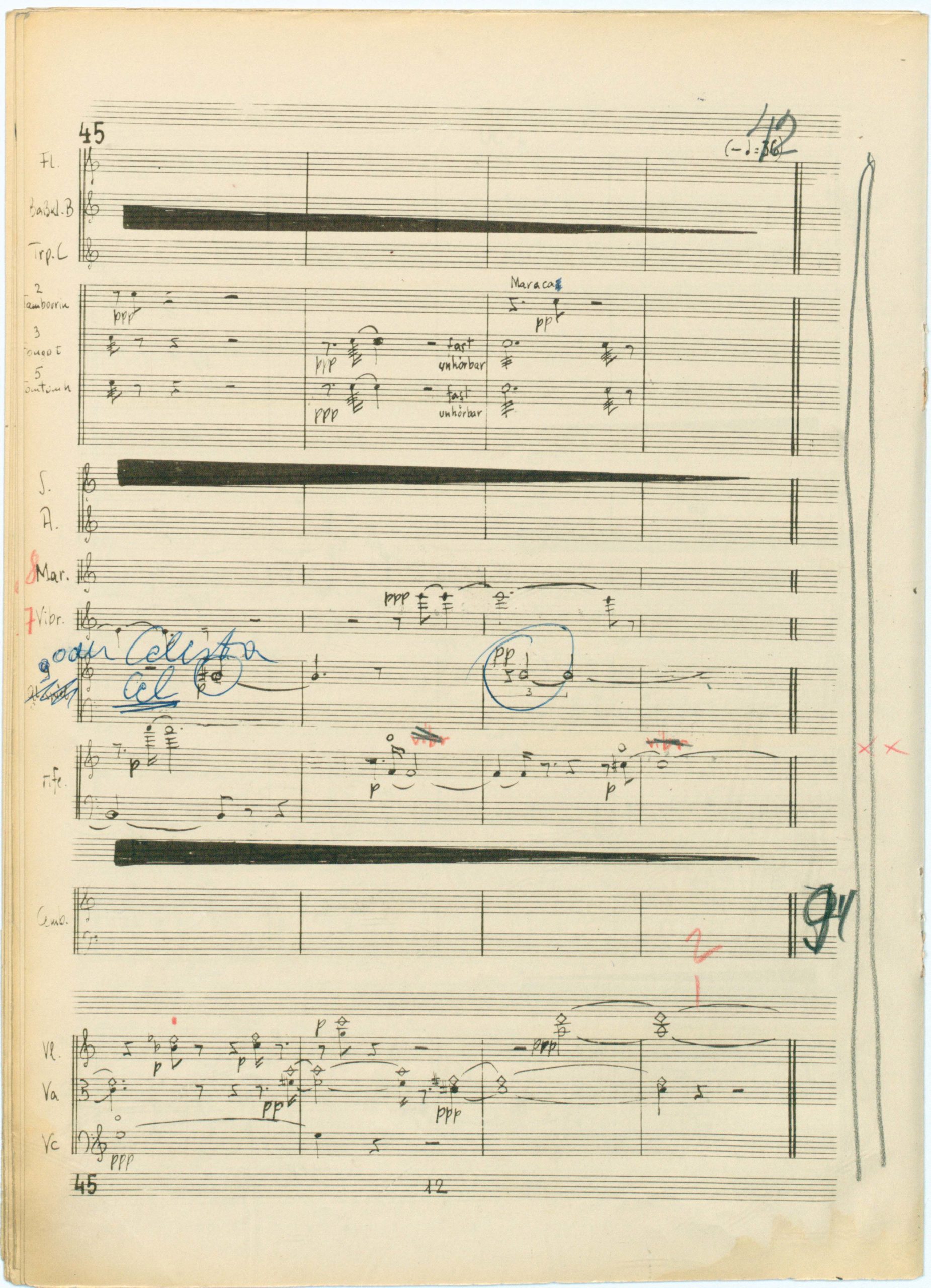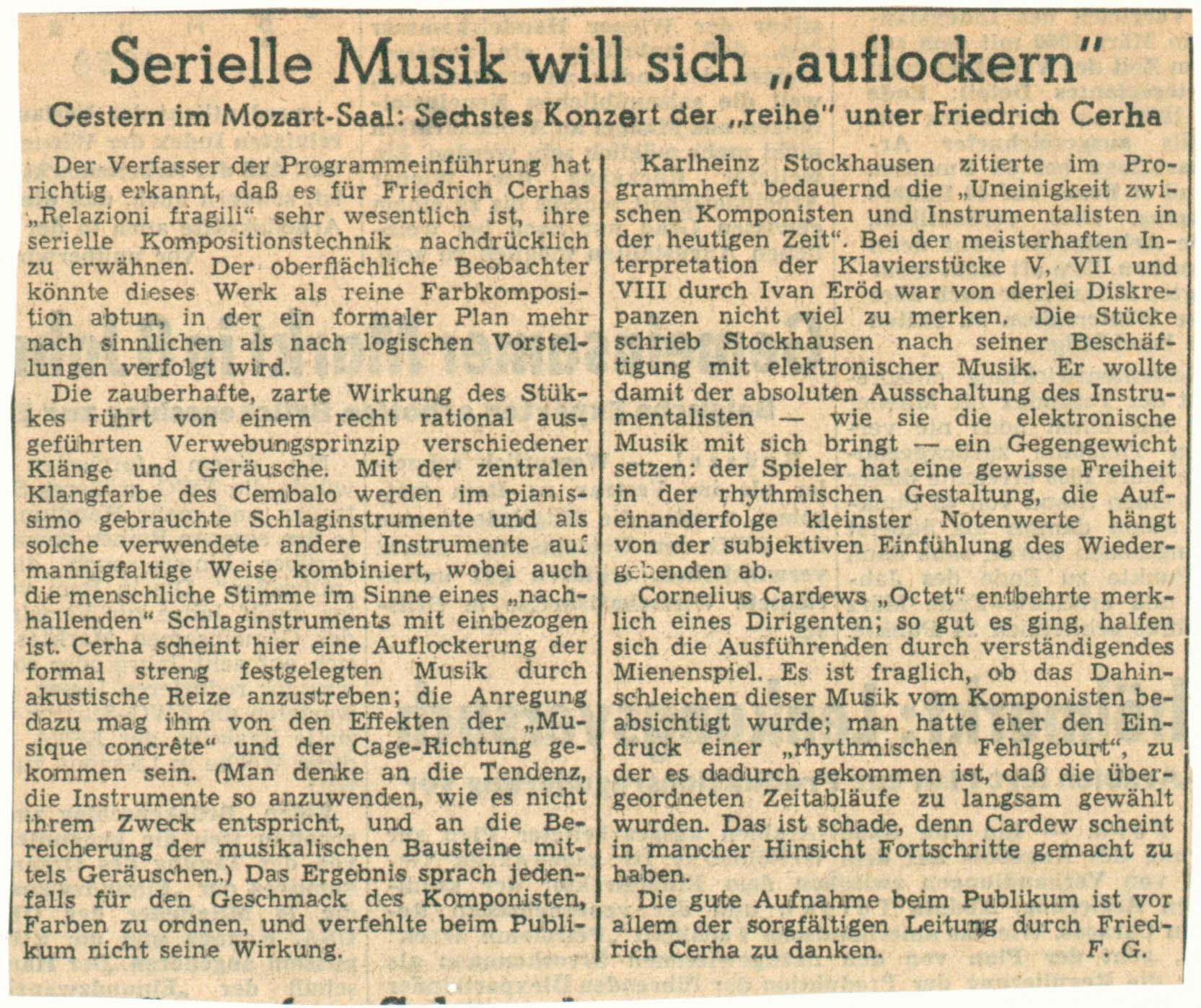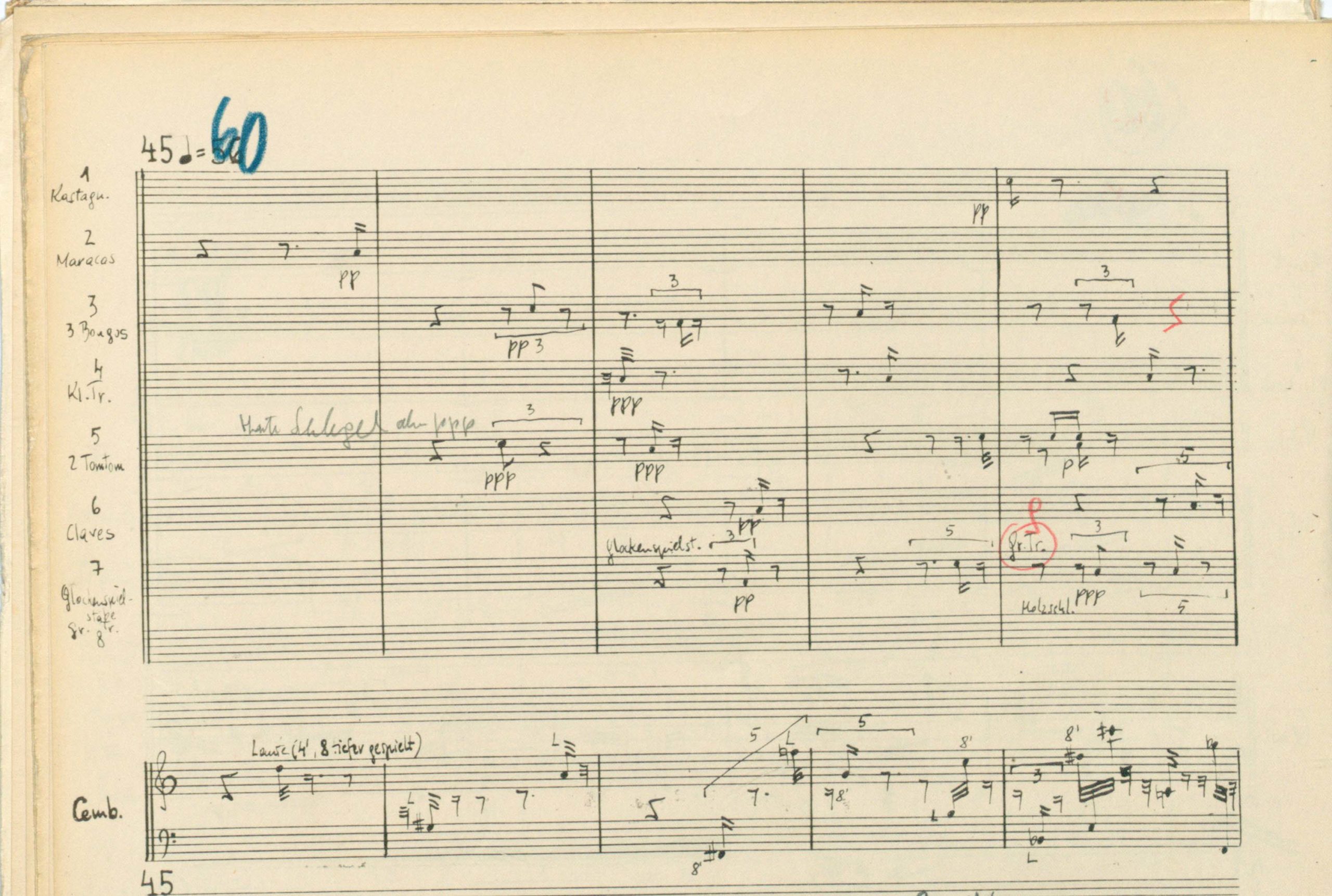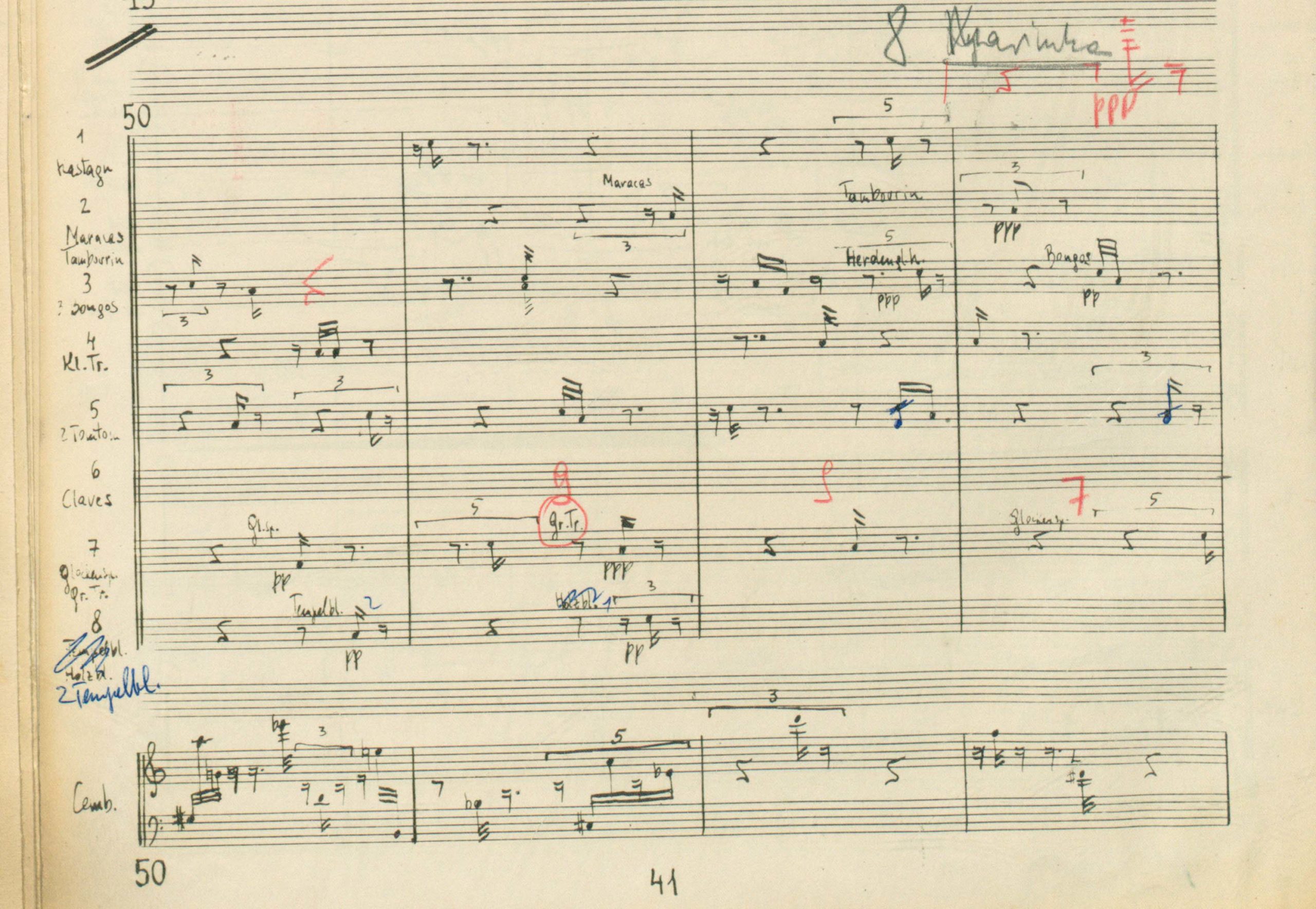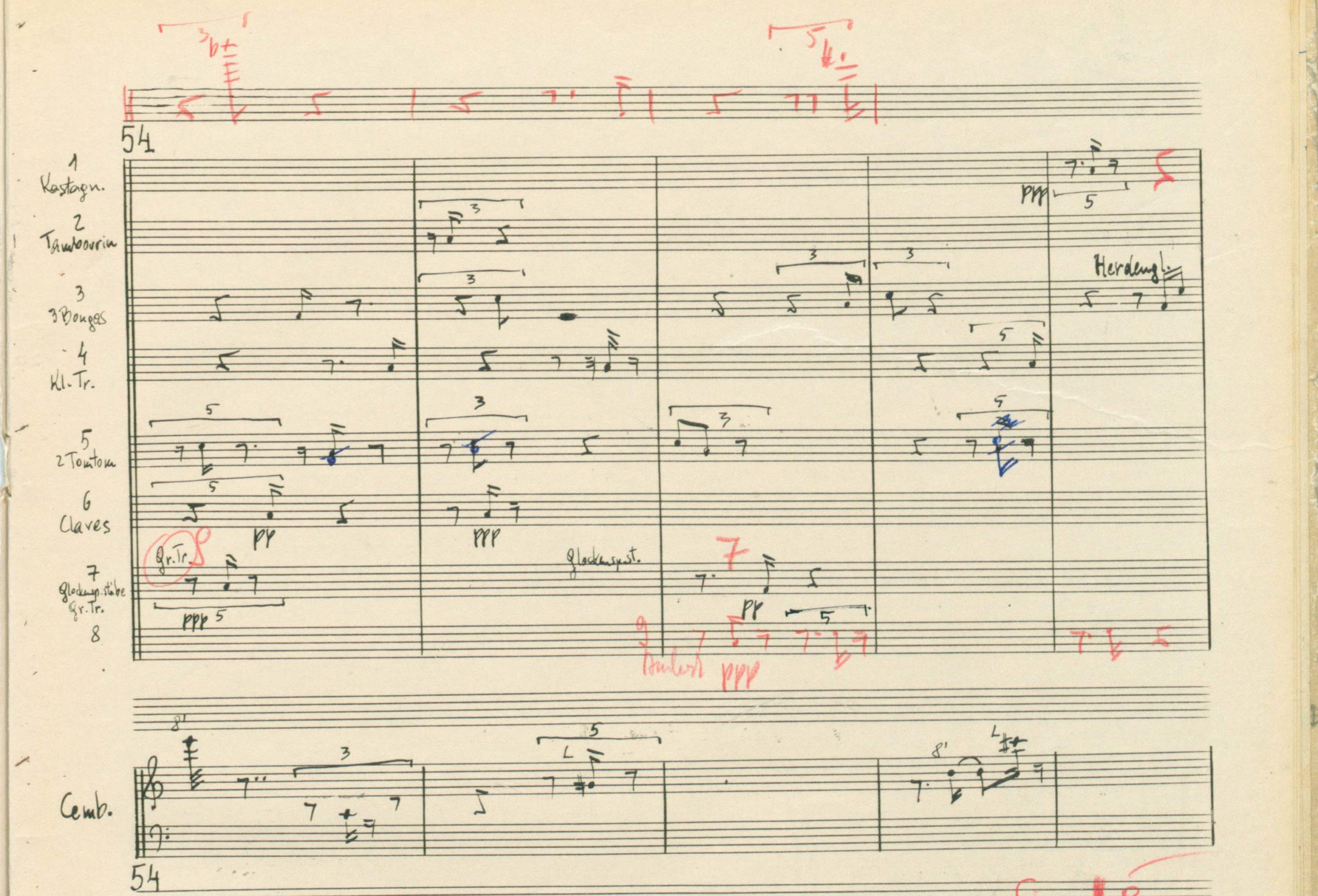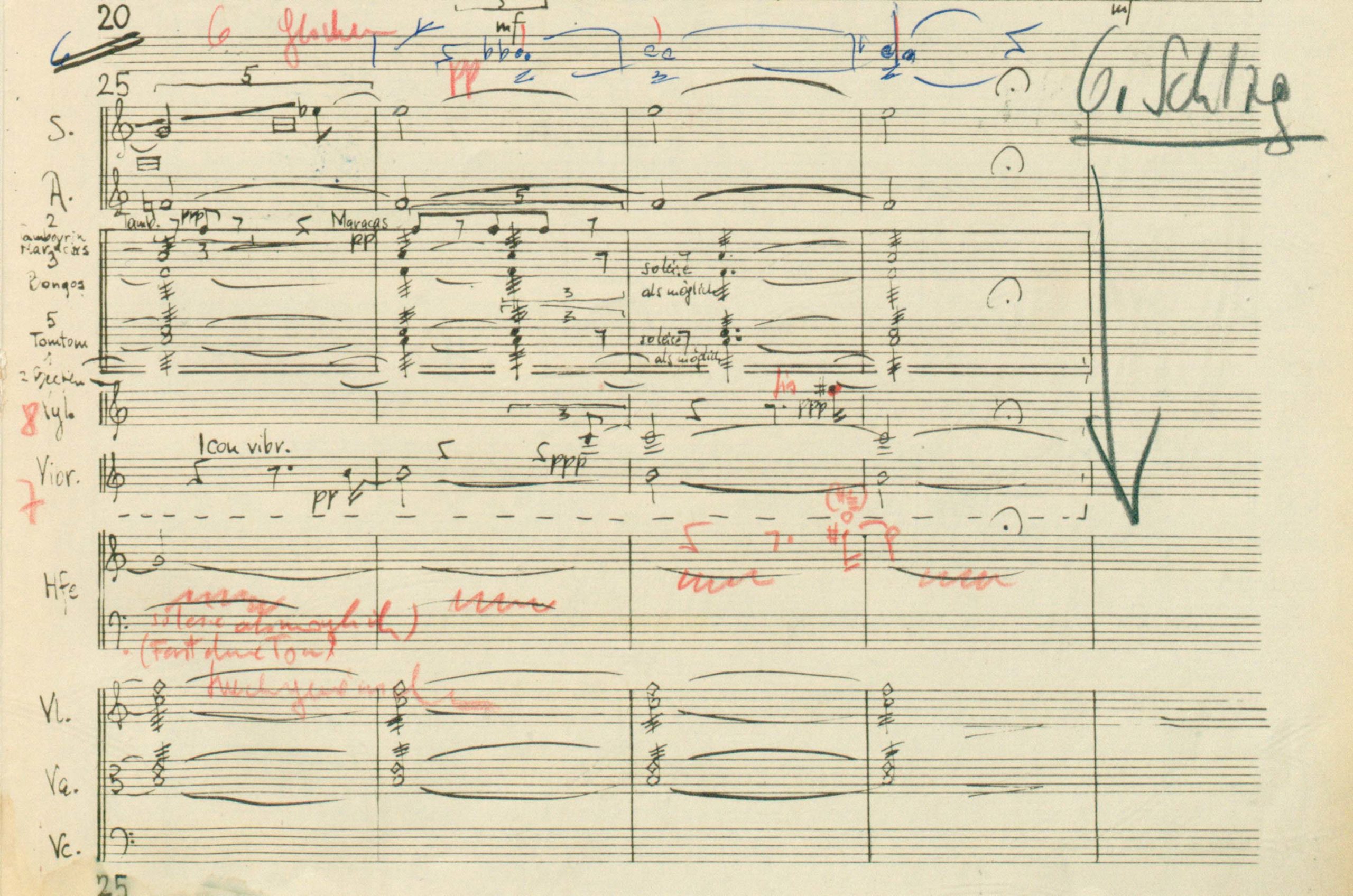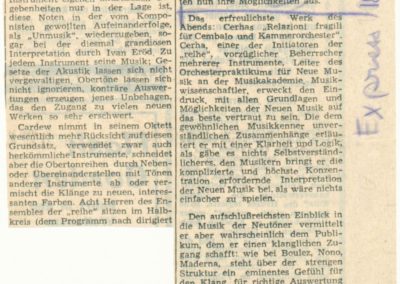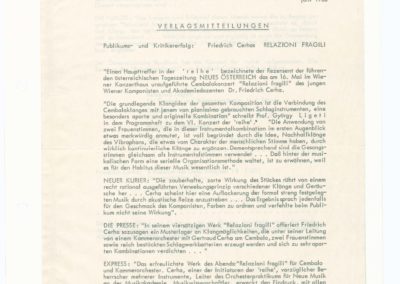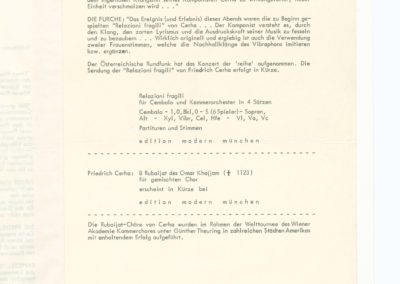Relazioni fragili
Serial Poetry
Enjambements
Spiegel
Harpsichord sounding board
made in France by Jean Denis II, 1648
Decorating instruments was a respected art form during the Baroque period, when it was not uncommon for paintings to adorn the wooden floors of keyboard instruments such as the harpsichord. In the twentieth century this baroque instrument experienced a revival, and Cerha has used it in numerous compositions.
Source: Daniel Jolivet/Flickr
Gestural dance and abstract music—can these apparent opposites even go together?
A ballet performance of Cerha’s Relazioni fragili proves that it is possible.
Aus: Zu Gast bei Friedrich Cerha, Dokumentation ORF, Wien 1975
The title of Cerha’s composition can be translated as “tender” or “fragile relationships”. This is also true of the dance interpretation of Relazioni, as no choreography was originally intended. Despite this, in 1974 a former ballet director of the Vienna State Opera, Aurel von Milloss, dared to implement one. Fantastical actors—including a dreamer, a demon, a silver being, and sirens—danced a fairy tale-like feeling into the music, something that at first glance may not seem to suit its “non-representational” character. The reason the connection still works is thanks to Cerha’s efforts to make the experience a tangible one …
Außenansicht
Cerha, registration form, Darmstädter Ferienkurse für Neue Musik, 1956,
Internationales Musikinstitut Darmstadt
For a 30-year-old Cerha, the summer of 1956 was a ground-breaking one. Thanks to his composition teacher Karl Schiske, he found his way to the “mecca” of the avant-garde, the Darmstadt Summer Courses for Neue Musik. Schiske also provided several other Austrian composers with scholarships for Darmstadt, including Cerha’s friends Kurt Schwertsik and Anestis Logothetis. Despite Schiske’s successful support, a downside also became apparent: Most Austrian composers lacked the opportunity to experience the musical pulse of the time until comparatively late. In Austria, “individuals preventing musical evolution were still in key positions, ones who had praised nationalist music in the Third Reich.“Lothar Knessl, „Die österreichische Kolonie“, in: Knessl er al. (eds.): Von Kranichstein zur Gegenwart. 50 Jahre Darmstädter Ferienkurse. 1946-1996. Stuttgart 1996, pp. 281-287, here p. 282 This meant that the newest developments “only occasionally came to Vienna in the beginning”Lothar Knessl, „Versuch, sich Friedrich Cerha zu nähern“, in: Schriften: ein Netzwerk, Vienna 2001, pp. 7-15, here p. 12, as musicologist Lothar Knessl puts it.
In the initially directionless 1950s, composers from other countries were already gaining an international reputation in the music scene. The most prominent among them included Karlheinz Stockhausen from Germany, Pierre Boulez from France, and Luigi Nono from Italy. Together, they formed a triad whose innovation can be summed up in a single term: serial music (also known as serialism). Their approach is simple: The composer dissects musical material like a scientist, breaking it down into its individual components—pitches, rhythms, volumes, timbres, even the spatial origin of the sounds. Rows are created using all these components, assembling the music layer by layer. The results were both revolutionary and problematic.
Friedrich und Gertraud Cerha
and colleagues, Darmstadt,
Internationales Musikinstitut Darmstadt
Brücke
Cerha explored serial music like a researcher forging into unknown territory. Before he created his first serial work, fresh ideas wholly new to him were reaching his inner ear and becoming the starting point for his new path. Cerha’s encounter with serial music in Darmstadt gave him the opportunity to create works that were no longer based on themes, motifs, and harmonies, but instead worked with the smallest particles—musical atoms, so to speak. He consistently describes his first work of this kind (Deux éclats en reflexion) as a fragment. It is a violin piece with piano accompaniment, testing the new terrain with an instrument that Cerha was familiar with as a violinist. Although the spirited piece evokes the impression of being “spontaneous and improvisational”, Cerha recalls “creating a large number of rhythmic cells”, “the sequence of which” he “considered for a very long time.“Schriften: ein Netzwerk, Vienna 2001, p. 222 In Cerha’s music, things that seem contradictory belong together: meticulous composition on the one hand, a free and reflexive unfurling of sound on the other.
violin: Friedrich Cerha, piano: Ivan Eröd, performance dates unknown
Cerha’s testing of serial structures after Deux éclats en reflexion, composed in 1956, gradually led towards a larger instrumental line-up. He composed another violin piece the same year, also with a French title: Formation et solution. Shortly thereafter, Cerha wrote the concept for Relazioni fragili, the first serial piece with multiple timbres. The chamber ensemble seems to have a soft spot for the extravagant and tonally noble: A solo harpsichord is particularly eye-catching. The broad range of percussion instruments is no less striking (nine players are needed), and two singers in particular stand out from the rest of the ensemble. However, the soprano and the mezzo-soprano do not sing lyrics, but instead act as two additional instruments with timbres consisting of vowels.
The idiosyncratic piece forms a group in conjunction with two other serial orchestral pieces, Espressioni fondamentali and Intersecazioni. All titled in Italian, the pieces can be traced back to Cerha’s visit to Rome. He stayed there for half a year, until the end of summer 1957, on a scholarship from the Austrian Ministry of Education. In Rome he not only met well-known colleagues, including Bernd Alois Zimmermann and Franco Evangelisti, but also managed a tremendous workload. Cerha was working on the scores of Relazioni fragili and Espressioni fondamentali at the same time, both of which were premiered three years later by Ernst Krenek in Berlin. Relazioni fragili was also premiered in 1960—by Cerha’s recently founded ensemble “die reihe”, together with piano pieces by Stockhausen and the premiere of Cornelius Cardew’s Octet, probably the first serial works to ever be heard in Vienna.
Innenansicht
One of the earliest documentations of Cerha conducting “die reihe” is a film recording of a rehearsal for Relazioni fragili, covering an excerpt from the second movement of the four-movement work. One sees not only Friedrich Cerha on the conductor’s podium, but also Gertraud Cerha on the harpsichord; she played the solo part at the premiere. The piece is one of the most impressive testimonies of a partnership that was also artistic.
Ensemble „die reihe“, Ltg. Friedrich Cerha, Gertraud Cerha (Cembalo), ca. 1960
Although the exact date of the recording is unknown, it is almost certainly from the early 1960s. At that time, “die reihe” performed Relazioni several times, including at the Warsaw Autumn Festival, on Hessischer Rundfunk television (both in 1961), and the Semaines Musicales in Paris (1962).
Pianist Alfred Brendel can be seen among a group of admirers. In a letter to musicologist Harald Kaufmann, he describes the Vienna music festival, writing that there was “only wasteland”—with the exception of the “single oasis” of Cerha’s Relazioni: “All breathed a sigh of relief to hear music once again (one that doesn’t sound antiquated anyway).” But what elevated the work so high above the others?
Alfred Brendel to Harald Kaufmann, 20 June 1961, AdZ, BRIEF001/16
In a way, using serial techniques requires a composer to give up a piece of creative freedom. The work is perhaps similar to that of an architect: There is first a design, which the construction then follows to the letter. A piece of music that keeps to a serial structure requires precise preparation. The first step is to compose the rows: rows for all twelve pitches, rows for rhythms, rows for volume levels, rows for articulation and playing styles, rows for timbres. It is even conceivable to have rows for the sequencing of sounds in space or for theatrical elements. All of these possible rows are ultimately played in different variations according to a plan—and rows can also be read backwards, or individual elements swapped. What finally emerges, however, eludes human comprehension in its details. The multitude of combinations and overlapping rows is simply unpredictable, resulting in music that is automatically generated from the circumstances.
And this unpredictability is not only for the composer. Finding one’s way through a serial piece of music is also considerably more difficult for the listener, who often can only grasp the complexity of the structural networks very superficially. Cerha positioned his music to counteract precisely this unfathomability. While embracing the potential of the compositional techniques so “fashionable” at the time was characteristic of Cerha, it is also unsurprising that he changed the way the techniques were used:
The new technical possibilities of serialism fascinated me, but at the same time I was immediately critical of a danger that was emerging in the results of early orthodox serialism. When the individual elements are systematically lined up at all levels of composition, the figurative context completely splinters, bringing with it a total abolition of reference points for the listeners and producing grey uniformity instead of the desired complexity. In order to counteract this danger, I deliberately did not push to atomize equally on all layers of the musical material, but instead worked with groups of elements in the rhythmic section, which is so essential for the creative experience.
Friedrich Cerha
Schriften: ein Netzwerk, Vienna 2001, p. 222
Cerha, Relazioni fragili (I), first section
Ensemble „die reihe“, Ltg. Friedrich Cerha, Gertraud Cerha (Cembalo)
Unlike many serial compositions, Relazioni emphasizes that the connections between the individual components are stronger than the differences. This creates the impression of music that is interwoven and interlocking, rather than disparate and amorphous. In the exposition-like beginning, for example, a handful of basic rhythmic shapes grow in strict combination with specific timbres. This can be heard with particular clarity in the three string parts: The violin and viola play a series of long durations, the individual elements of which are heard both in alternation and superimposed. This results in a delicate layer of sound that is often enriched with overtones and merged with the equally long notes of the vibraphone, celesta, harp, and flute. The cello, on the other hand, takes on a different role altogether: Its series consists entirely of short notes, either plucked or made by tapping a finger on the strings. Various percussion instruments are then added to the resulting percussive sound (tambourine, bongos, snare drum, and marimba).

Cerha, Relazioni fragili, handwritten score, AdZ, 00000049/8
After a few bars, the solo harpsichord intervenes between the two fundamentally distinct ensemble groups. The harpsichord series consists of rhythmically similar figures (often triplets) which create a melody that can almost be said to be two-part—a design device frowned upon in serialism that Cerha does not avoid in order to fit in with the times. All three layers of music in the opening section are interwoven to create a highly differentiated musical structure with a unified appearance. The way that various rhythmic movement patterns are superimposed to create musical shapes is reminiscent of another of Cerha’s serial works, Espressioni fondamentali, which was composed at the same time. Its first movement also begins with a passage in which the emerging “forms of movement are interlocked and intertwined.“Cerha, commentary on Espressioni fondamentali, AdZ, 000T0051/5 as Cerha points out.
Relazioni fragili (I), first section
Ensemble „die reihe“, Ltg. Friedrich Cerha, Gertraud Cerha (Cembalo)
Espressioni fondamentali (I), first section
RSO Wien, Ltg. Friedrich Cerha, ORF-Funkhaus Wien, Großer Sendesaal, 1994,
CD: Edition Zeitton. Neue Musik aus Österreich, ORF 1997, LC 5103, CD 160
In comparing the beginnings of the two pieces, once can discern a pattern of thinking in sections, in addition to the “variable and distinctive figures” developed by Cerha. Schriften: ein Netzwerk, Vienna 2001, p. 222 The musical development extends to a certain point before there is a small break and something new begins. In Relazioni fragili, the calm and spacious opening section is followed by a rapidly mounting passage of only four bars. It is characterized throughout by brief, rhythmic cells chained together in a series, their layers lending the musical flow a sudden, far greater motion. The entire movement is characterized by such changes, carrying forth a variation of the serial concept from a bird’s eye view: Even sections are arranged into a series.
Cerha, Relazioni fragili, handwritten score, 1st movement, AdZ, 00000049/8
Cerha, Relazioni fragili, 1st movement
Ensemble „die reihe“, Ltg. Friedrich Cerha, Gertraud Cerha (Cembalo)
Variations in colour are the main factors in the changing characters. For example, at the break point from the opening to the second section, Cerha exchanges the ethereal colours of the vibraphone, celesta, harp, and female vocalists for the dominant wind instruments (bass clarinet, trumpet, and flute). His earlier contemporaries also recognised the special significance of timbre in Cerha’s music. For example, a review of the premiere of Relazioni fragili (Vienna, Konzerthaus, 16 May 1960), stated that a superficial observer could dismiss the piece “as a pure colour composition in which any formal plan is based more upon sensual than logical ideas.“F.G:, “Serielle Musik will sich auflockern”, unknown newspaper, AdZ, KRIT0008/37
György Ligeti likewise understood the significance of changing colours in his friend’s compositional style, expressing a special interest in Relazioni fragili. Together with Cerha’s serial violin pieces, “this harpsichord concerto is Austria’s most important contribution to the music of the 1950s, stylistically related to the Darmstadt and Cologne movement, but highly personal and original.“ György Ligeti, “Ein wienerischer Untertreiber”, in: ibid., Gesammelte Schriften, Monika Lichtenfeld (ed.), Mainz 2007, Vol. 1, pp. 470–472, here p. 472 Ligeti insisted on writing an introduction for the premiere.
Ligeti’s interest in the third movement of the Relazioni fragili, expressed in the programme intro, also affected his own aesthetic ideas. The two types of composition that he describes can be found in his own works. Soft, osmotic, tightly intertwined textures are characteristic of compositions such as Atmosphères (1961) and Lontano (1967). Disparate and rhythmic layers, on the other hand, can be found in Aventures (1962), premiered by Cerha with “die reihe”.
In addition to the external sound stimuli, Ligeti’s interest was particularly aroused by the structural connections: the interactions between the two opposing manifestations. Two “areas where one of the two types prevails” are briefly presented in order to make the piece’s structure more comprehensible.
The particularly typical and, according to Ligeti, “distinctive and original combination” of short harpsichord notes with the crackling and popping of various percussion instruments is demonstrated at one point in the movement. “A dry sound” family predominates: castanets, maracas, bongos, claves, and many other instruments. Just a glance at the score reveals this character immediately. Mostly single notes are layered on top of each other, resulting in a grainy sound texture. This passage is a prime example of punctuated style, the earliest variety of serialism. It starts with an individual sound event and, as its name suggests, creates tonal points. In Cerha’s work, this way of composing is usually only episodic.
Cerha, Relazioni fragili (III), T. 45-63
Ensemble „die reihe“, Ltg. Friedrich Cerha, Gertraud Cerha (Cembalo)
The second figure Ligeti describes, the “gelatinous, dense, soft, and sensitive” fabric, dispenses with punctuation entirely. The fluctuating upward and downward movements of the strings and the two singers combine to form a horizontally unfurling surface. A passage at the beginning of the movement makes the form clear. Here the softness is in the foreground, while the punctuated structures of the drummer are discernible in the background. The dominance of one type of fabric suppresses the presence of the other.
Cerha, Relazioni fragili (III), T. 20-28
Ensemble „die reihe“, Ltg. Friedrich Cerha, Gertraud Cerha (Cembalo)
The opposite example, namely the repression of the soft, glissanding surface, occurs towards the end of the movement. Here the family of sounds, described by Ligeti as having reverberation, are brought to the fore. Again, the percussive register is present, albeit with very different instruments (cymbals, gongs, bells, and vibraphone, for example). Also part of the mix: the harp, acting as a kind of softer, darker, resonant counterpart to the plucked sound of the harpsichord. Strong blows or cracks on these instruments mediate between the punctuated and the affectless: A single note often unfurls into reverberation. Together, the multitude of instruments that continue to appear finally covers the soft texture of the strings and voices. Only a gradually established “decompression” brings it back to the surface at the end of the movement.
Relazioni fragili (III), finale
Ensemble „die reihe“, Ltg. Friedrich Cerha, Gertraud Cerha (Cembalo)
A feature that characterizes not only the third movement so admired by Ligeti, but also Relazioni as a whole, can be seen in the opposition of state and process. The formation of textures using the serial technique shows Cerha’s attention to detail to the perfection of differentiated, precisely formed elements and their connections. The sound conditions that arise have a specific and unique flavour, and Cerha is particularly interested in developing such states. By bringing together different, sometimes even contradictory or opposing states, a special tension arises that is unique to Relazioni fragili. The composer puts it thus:
There are block formations in the piece that have a static effect, but there are also changes of state. The fact that this mainly take place at joints, at deliberate breaking points, shows how much I was concerned with “dispersion” and “composition” in the overall form and at the same time in detail. What still appeals to me about the piece today is its oscillation between listening to the state of things and experiencing the form.
Friedrich Cerha
Schriften – ein Netzwerk, Vienna 2001, p. 61.
Relazioni fragili continued to write composing history after its premiere in 1960: Cerha picked up the piece again and expanded it in several places (increasing, among other things, the percussion section). The handwritten revisions to a copy of the manuscript provide fascinating insights into the composer’s workshop. The entire third movement is summarised in sometimes deserted pages of the score, as shown in a recording of “die reihe” from 1976. Conducting: Friedrich Cerha; on the harpsichord: Gertraud Cerha.
Conducting: Friedrich Cerha; on the harpsichord: Gertraud Cerha.

